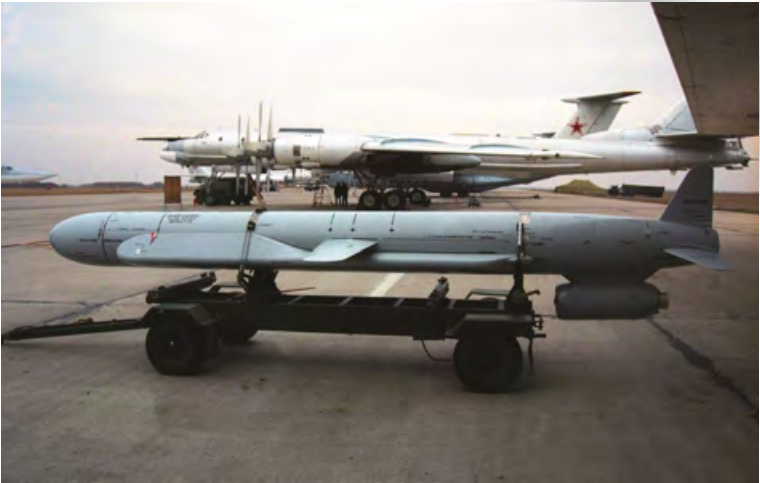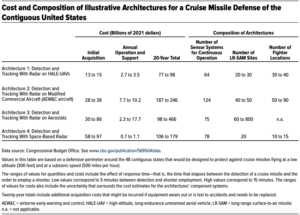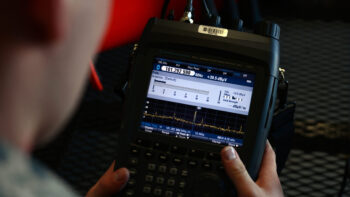
China CJ-10 LACM
WASHINGTON: Building a new defensive network against cruise missiles could cost anywhere between $75 billion to $465 billion over 20 years, depending on whether the goal is to protect selected high-value facilities or the entire US.
Those are the findings of a new study by the Congressional Budget Office (CBO). The cost estimates include $13 billion to $97 billion for initial acquisition and $700 million to $18 billion per year for operation and support, as well as additional costs to replace systems that wear out or are lost to accidents.
The report, National Cruise Missile Defense: Issues and Alternatives, raises questions about the cost-effectiveness of a “wide-area” defense capability.
The study says: “Cruise missiles could be defeated with available technology, but a wide-area defense of the contiguous United States would be costly. CBO estimates the lowest-cost ‘architectures’ it examined—integrated systems that comprise airborne or space-based radars, surface-to-air missiles, and fighter aircraft—would cost roughly $75 billion to $180 billion to acquire and operate for 20 years. Fielding additional regional or local defenses to protect Alaska, Hawaii, and U.S. territories would add to the cost.”
“We’re not going to be able to defend every acre of North America,” Tom Karako, director of the Missile Defense Project at the Center for Strategic and International Studies (CSIS), said bluntly. “Instead of spreading thin, a more realistic approach is to construct relatively thicker defense of a smaller defended asset list, comprised of key political, military, and economic centers.”
Besides costs, the study also finds that there are operational obstacles to cruise missile defense of the homeland — such as the difficulty of rapidly distinguishing between incoming missiles and civilian aircraft. Another problem is the short time to find, track and respond to an incoming missile. Adversaries might also launch missile barrages that would overwhelm defenses in a specific location. “Even advanced battle management systems might be hard-pressed to respond in time,” CBO finds.
At the same time, the study also raises questions about whether adversaries would chose expensive land-attack cruise missiles (LACMs) rather than cheaper alternatives (such as existing ballistic missiles) to strike US territory. Thus, US “decisionmakers would need to consider whether the cost of a wide-area cruise missile defense was proportionate to the overall risk posed by LACM,” CBO says.
Cruise missile defense (CMD) costs are closely tied to what types of sensors are chosen to detect the targets, which fly low and fast, and are likely to evade US ballistic missile defense radar and tracking sensors, the study finds. “The most significant factor determining the effectiveness of a CMD is the range of its radar sensors, which, in turn, is determined primarily by their altitude,” CBO says. The study looked at five different radar platforms:
- Towers on the ground at a total height of at least 700 feet (including the elevation of local terrain),
- Tethered aerostats (blimps) at 10,000 feet,
- Commercial aircraft modified for airborne early warning and control (AEW&C) at 30,000 feet,
- High-altitude, long-endurance unmanned aerial vehicles (HALE-UAVs) at 60,000 feet, and
- Satellites orbiting about 600 miles above Earth.
 “Establishing an unbroken, continuously operating radar perimeter of the contiguous United States to provide warning about a low-altitude cruise missile (flying at 300 feet) would require one of the following: 23 orbits of HALE-UAVs (requiring 64 aircraft to keep one continuously aloft at each location); 31 orbits of AEW&C aircraft (requiring 124 aircraft); 50 tethered aerostat sites (requiring a total of 75 aerostat systems), 78 radar satellites, or 150 ground-based radar sites,” the study concluded.
“Establishing an unbroken, continuously operating radar perimeter of the contiguous United States to provide warning about a low-altitude cruise missile (flying at 300 feet) would require one of the following: 23 orbits of HALE-UAVs (requiring 64 aircraft to keep one continuously aloft at each location); 31 orbits of AEW&C aircraft (requiring 124 aircraft); 50 tethered aerostat sites (requiring a total of 75 aerostat systems), 78 radar satellites, or 150 ground-based radar sites,” the study concluded.
As for “shooters,” CBO looked at long-range surface-to-air missiles (LR-SAMs), and fighter aircraft on alert at airfields around the country.”
The study did not, however, “consider infrared sensors or new types of weapons such as lasers or other directed-energy weapons because those systems will probably have ranges that are too short for wide-area CMD,” CBO caveats.
“By running the cost of blanketing CONUS with ground-based radars and point defenses, the report points strongly, if quietly, toward two conclusions: cruise missile defense requires elevated and distributed sensors, and homeland cruise missile defense will require a shift to prioritizing more limited or preferential defense goals,” Karako said.
DoD’s primary effort to detect and track cruise missiles — especially hypersonic cruise missiles that fly faster than Mach 5 — is the nascent Space Development Agency (SDA) program to develop a Tracking Layer of potentially hundreds of Low Earth Orbit (LEO, below 2,000 kilometers in altitude) satellites.
SDA awarded SpaceX $149 million and L3Harris $194 million to each build four LEO sats carrying wide-field-of-view IR sensors as part of what it calls “Tranche 0” — i.e. a demo version — of its planned, seven-layer National Defense Space Architecture. SDA plans to begin launching the satellites next year, and to have all eight on orbit by March 31, 2023.
Further, as part of the SDA Tracking Layer, the Missile Defense Agency in January awarded contracts to L3Harris and Northrop Grumman to demonstrate a different type of space-based sensor — the Hypersonic and Ballistic Space Sensor (HBTSS) — specifically aimed at tracking hypersonic missiles. L3Harris received $121 million on Jan. 14; and Northrop Grumman $155 million on Jan. 22. Each will develop a prototype medium field-of-view sensor. Those satellites also are expected to be launched in 2023.
Air Force’s legislative proposal is an existential threat to the National Guard
In this op-ed, Francis M. McGinn, the head of the National Guard Association, blasts an Air Force proposal to transfer National Guard units performing space missions to the Space Force.



























